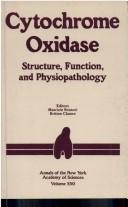| Listing 1 - 6 of 6 |
Sort by
|

ISBN: 0897664841 089766485X Year: 1988 Volume: 550 Publisher: New York, N.Y. New York Academy of Sciences
Abstract | Keywords | Export | Availability | Bookmark
 Loading...
Loading...Choose an application
- Reference Manager
- EndNote
- RefWorks (Direct export to RefWorks)
Legs Homès - Van Schoor
Enzymology --- Cytochrome oxidase --- Electron Transport Complex IV --- Congresses. --- Pathophysiology --- congresses. --- Cytochrome Oxidase --- CYTOCHROME OXIDASE --- Congresses --- Physiology [Pathological ]
Book
ISBN: 0123336406 0323143261 1299460895 9780123336408 Year: 1974 Publisher: New York (N.Y.): Academic press
Abstract | Keywords | Export | Availability | Bookmark
 Loading...
Loading...Choose an application
- Reference Manager
- EndNote
- RefWorks (Direct export to RefWorks)
Enzymology --- Molecular biology --- Human biochemistry --- Oxygenases --- Oxygenases. --- Oxidoreductases --- Oxygenase --- OXYGEN --- SUPEROXIDE DISMUTASE --- CYTOCHROME-C OXIDASE --- PEROXIDASE --- OXYGENASE --- FATTY ACIDS --- CYTOCHROME OXIDASE --- BIOLOGICAL STUDIES
Article
Abstract | Keywords | Export | Availability | Bookmark
 Loading...
Loading...Choose an application
- Reference Manager
- EndNote
- RefWorks (Direct export to RefWorks)
The present study evaluated whether environmental enrichment-related effects on the development of stereotyped behavior in deer mice were associated with alterations in neuronal metabolic activity. Deer mice were reared under either enriched or standard housing conditions for 60 days following weaning. All mice were then placed in automated photocell detectors and classified as either stereotypic or non-stereotypic. Neuronal metabolic activity was then assessed using cytochrome oxidase (CO) histochemistry. The results demonstrated that environmental enrichment significantly increased neuronal metabolic activity in the motor cortex. Furthermore, non-stereotypic mice exhibited significantly more CO activity than stereotypic mice in the cortex, striatum, nucleus accumbens, thalamus, hippocampus and amygdala. This latter effect was due to the enriched mice as evidenced by a significant interaction between housing condition and behavioral status in the cortex, striatum, nucleus accumbens, thalamus and hippocampus. Thus, the observed increase in CO activity reflected increased neuronal metabolic activity in non-stereotypic enriched mice relative to stereotypic enriched mice. These results suggest that, in a developmental model of spontaneous stereotypy, the enrichment-related prevention of stereotyped behavior is associated with increased CO activity. (C) 2002 Elsevier Science B.V. All rights reserved
Accumbens. --- Activity. --- Amygdala. --- Bank voles. --- Basal ganglia. --- Behavior. --- Brain variations. --- Cortex. --- Cytochrome oxidase,repetitive behavior,mouse,brain. --- Cytochrome-oxidase activity. --- Deer mice. --- Deer. --- Development. --- Enriched. --- Enrichment. --- Environmental enrichment. --- Hippocampus. --- Housing conditions. --- Housing. --- Increase. --- Interaction. --- Lurcher mutant. --- Macaque striate cortex. --- Mice. --- Model. --- Motor coordination. --- Neuronal. --- Nonhuman-primates. --- Nucleus accumbens. --- Nucleus-accumbens. --- Nucleus. --- Prevention. --- Quantitative em analysis. --- Stereotyped behavior. --- Stereotypic. --- Stereotypies. --- Stereotypy. --- Striatum. --- Visual-cortex. --- Weaning.
Book
ISBN: 3036554572 3036554580 Year: 2022 Publisher: MDPI - Multidisciplinary Digital Publishing Institute
Abstract | Keywords | Export | Availability | Bookmark
 Loading...
Loading...Choose an application
- Reference Manager
- EndNote
- RefWorks (Direct export to RefWorks)
Over the last few years, the subject of food authenticity and food fraud has received increasing attention from consumers and other stakeholders, such as government agencies and policymakers, control labs, producers, industry, and the research community. Among the different approaches aiming to identify, tackle, and/or deter fraudulent practices in the agri-food sector, the development of new, fast, and accurate methodologies to evaluate food authenticity is of major importance. This book, entitled “Target and Non-Target Approaches for Food Authenticity and Traceability”, gathers original research and review papers focusing on the development and application of both targeted and non-targeted methodologies applied to verify food authenticity and traceability. The contributions regard different foods, among which some are frequently considered as the most prone to adulteration, such as olive oil, honey, meat, and fish. This book is intended for readers aiming to enrich their knowledge through reading contemporary and multidisciplinary papers on the topic of food authentication.
Technology: general issues --- COIBar–RFLP (cytochrome oxidase I barcode–restriction fragment length polymorphism) --- seafood --- fraud --- DNA barcoding --- food authenticity --- food adulteration --- food fraud --- donkey --- cytochrome b --- real-time PCR --- meat products --- honey --- regional origin --- chemometric analysis --- mineral content --- Montenegro --- Sepia --- common cuttlefish --- Sepia officinalis --- real-time PCR (Polymerase Chain Reaction) --- species identification --- food authentication --- COI (Cytochrome Oxidase I) --- Olea europaea var Sylvestris --- oleaster --- olive --- olive oil --- adulteration --- SNP --- DNA --- virgin olive oil --- quality --- volatile compounds --- sensory analysis --- chemometrics --- anti food fraud --- Curcuma longa --- DNA markers --- SYBR-GREEN real-time PCR --- Zea mays --- pasta --- Triticum aestivum --- Triticum durum --- genetic traceability --- digital PCR --- semolina --- species --- truffle --- Tuber spp. --- species differentiation --- near-infrared spectroscopy --- red deer --- roe deer --- water deer --- multiplex PCR --- capillary electrophoresis --- perilla --- sesame --- geographic origin --- metabolomics --- multivariate analysis --- metabolite profiling --- quantification --- chicken --- guinea fowl --- pheasant --- quail --- turkey --- authentication --- authenticity --- chemometric --- fish --- origin --- meat --- milk --- spectroscopy --- 1H-NMR --- GC-MS --- HPLC-UV/VIS --- protein hydrolysate --- free amino acid contents --- ProHydrAdd --- monofloral honey --- direct analysis in real time (DART) --- high resolution mass spectrometry (HRMS) --- geographical origin --- Ginkgo biloba --- plant infusions --- real-time polymerase chain reaction --- DNA extraction --- opium poppy --- seed --- pollen grains --- bakery product --- oil --- PCR --- Salmo salar L. --- fatty acids --- mislabeling --- machine learning --- n/a --- COIBar-RFLP (cytochrome oxidase I barcode-restriction fragment length polymorphism)

ISBN: 4431702024 4431684786 443168476X Year: 1998 Publisher: Tokyo Springer
Abstract | Keywords | Export | Availability | Bookmark
 Loading...
Loading...Choose an application
- Reference Manager
- EndNote
- RefWorks (Direct export to RefWorks)
This first volume in a projected series contains the proceedings of the first of the Keio University International Symposia for Life Sciences and Medicine under the sponsorship of the Keio University Medical Science Fund. As stated in the address by the President of Keio University at the opening of the 1996 symposium, the fund of Dr. Mitsunada Sakaguchi. The Keio was established by the generous donation University International Symposia for Life Sciences and Medicine constitute one of the core activities of the fund. The objective is to contribute to the international community by developing human resources, promoting scientific knowledge, and encouraging mutual exchange. Every year, the Executive Committee of the Interna tional Symposia for Life Sciences and Medicine selects the most interesting topics for the symposium from applications received in response to a call for papers to the Keio medical community. The publication of these proceedings is intended to publicize and distribute information arising from the lively discussions of the most exciting and current issues during the symposium. Weare grateful to Dr. Mitsunada Sakaguchi, who made the symposium possible, the members of the program committee, and the office staff whose support guaran teed the success of the symposium. Finally, we thank Springer-Verlag, Tokyo, for their assistance in publishing this work. Akimichi Kaneko, M. D. , Ph. D.
Human biochemistry --- Oxygen --- Homeostasis. --- Oxygenases. --- Cytochrome oxidase --- -Cytochrome P-450 --- -Oxygen --- -Respiration --- -Animal respiration --- Animals --- Breathing --- Ventilation (Physiology) --- Physiology --- Vital signs --- Aerobic exercises --- Breathing exercises --- Chalcogens --- Nonmetals --- Photosynthetic oxygen evolution --- Cytochromes --- Metalloenzymes --- Monooxygenases --- Cytochrome a3 --- Cytochrome c oxidase --- Indophenol oxidase --- Indophenolase --- Respiratory enzyme --- Warburg's respiratory enzyme --- Oxidoreductases --- Autoregulation --- metabolism. --- Congresses --- Metabolism --- -Congresses --- Respiration --- Cytochrome P-450 --- Homeostasis --- Oxygenases --- Congresses. --- metabolism --- congresses. --- -metabolism. --- Metabolism&delete& --- Oxygenase --- Neurosciences. --- Human physiology. --- Cell biology. --- Animal physiology. --- Human Physiology. --- Cell Biology. --- Animal Physiology. --- Cell biology --- Cellular biology --- Biology --- Cells --- Human biology --- Medical sciences --- Human body --- Neural sciences --- Neurological sciences --- Neuroscience --- Nervous system --- Animal physiology --- Anatomy --- Metabolism.
Book
ISBN: 3036560424 3036560416 Year: 2022 Publisher: Basel MDPI - Multidisciplinary Digital Publishing Institute
Abstract | Keywords | Export | Availability | Bookmark
 Loading...
Loading...Choose an application
- Reference Manager
- EndNote
- RefWorks (Direct export to RefWorks)
This reprint is a collection of papers on different aspects of the diversity and ecology of marine decapod crustaceans, including integrative taxonomy and genetic diversity, DNA barcoding to match larvae to adults, predator–prey interaction, coral–crab symbiosis, Sargassum–shrimp symbiosis, population dynamics of pelagic shrimps, diversity and distribution of oceanic larvae, spatial distribution of crabs, biodiversity of lobsters, and ecology of cave decapods. These contributions illustrate the variety of life forms, habitat use, and interspecific relationships exhibited by decapod crustaceans, one of the most diverse and abundant marine taxa.
Research & information: general --- Biology, life sciences --- cytochrome c oxidase subunit I (COI) --- larval dispersal --- mitochondrial genes --- molecular data --- 16S rRNA --- redescription --- Belzebub --- Lucifer --- sex ratio --- size structure --- size at first maturity --- population ecology --- symbiosis --- Sargassum shrimps --- chemical cues --- sponge shrimp --- coral cleaner shrimp --- taxonomy --- cytochrome oxidase 1 --- 16S ribosomal RNA --- association --- southwest Pacific Ocean --- ecology --- crustacean --- crab --- coral --- DNA barcoding --- Gulf of Mexico --- Caridea --- Dendrobranchiata --- Decapoda --- larval-adult matching --- life history --- decapods --- spiny lobsters --- slipper lobsters --- phyllosoma --- Caribbean Sea --- Yucatan Current --- lobster --- life cycle --- predator-prey --- food chain --- Brazil --- hermit crab --- Paguridae --- diversity --- molecular phylogeny --- species inventory --- zoogeography --- species richness --- depth preference --- cave zonation --- secondary stygobiosis --- trophic depletion --- protected species --- Cyclograpsus cinereus --- spatial distribution --- intertidal --- rocky shore --- negative binomial distribution --- n/a
| Listing 1 - 6 of 6 |
Sort by
|

 Search
Search Feedback
Feedback About UniCat
About UniCat  Help
Help News
News